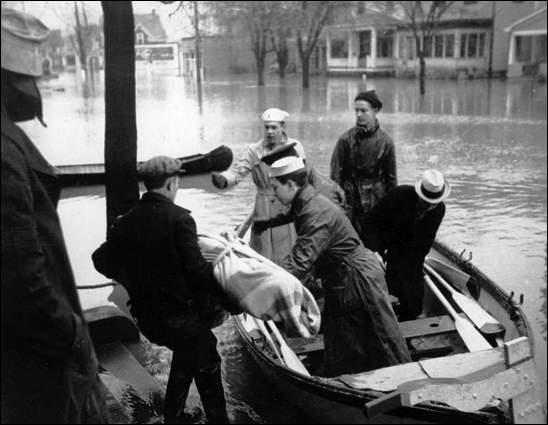The Poetry of Jennifer Schomburg Kanke

“Bessie’s gone under the water,/baby held high in the air/hoping that someone will grab her./Safety was only a few streets away/when the boat capsized/into the flooded street./Men in the nearby john boats/quickly plucked her boys out,/then reached for Bertie./When they turned back for the mother,/fingers making contact,/second of hope split in pieces/as the Ohio made its claim./Is it still the river/when it runs the muddy streets?/When it leaves its quiet banks wandering in search of adventure?—Jennifer Schomburg Kanke
Speculative Friction
By Claire Bateman

GREENVILLE South Carolina—(Hubris)—June & July 2024—The creation of poet Jennifer Schomburg Kanke’s multi-part long poem “Scenes from the Flood,” about the Ohio River Flood of 1937, involved “a balancing of the scholarly and the spiritual,” as the poet describes her writing process. Her goal was to make readers feel as though they were emerging from a time machine rather than reading a poem, a process that relied heavily on immersing herself in as many stories as possible. Beginning with researching recorded first-person accounts of those directly affected by the flood (including an audio tape of her own grandmother), she also read newspaper articles from the time as well as later retrospectives.
Another important part in the drafting of the poem was en-rhythming, a term coined by the poet Annie Finch to describe the process of “accustoming one’s ear and body to the sound of a particular rhythm in preparation for writing, reading, or scanning that meter” (How to Scan a Poem, 2023). Additionally, Finch posits that each meter has corresponding energies and elements. Because water is associated with the dactylic meter in this system, Kanke chose to en-rhythm to Henry Wadsworth Longfellow’s Evangeline, a poem in dactylic hexameter.
Because her goal was not to write a metrical poem, but rather to present an experience which might be heightened by meter, she did not worry if her metrical substitutions were acceptable or if the line breaks came at the end of a foot, and thus she was able to allow herself to be driven on with the current.
Jennifer Schomburg Kanke’s work has recently appeared in New Ohio Review, Massachusetts Review, Shenandoah and Salamander. She is the winner of a Sheila-Na-Gig Editor’s Choice Award for Fiction. Her zine about her experiences undergoing chemotherapy for ovarian cancer, Fine, Considering, is available from Rinky Dink Press (2019). Her full-length poetry collection, The Swellest Wife Anyone Ever Had, about Appalachian Ohio, will be available from White Violet Press (the formalist imprint of Kelsay Books) in Fall 2024.
She is currently at work on a reimagining of Evangeline set in North Florida in the mid-1980s, as well as a novel that answers the question “What if Wordsworth wrote Fried Green Tomatoes after reading Gravity’s Rainbow?” She can be found on YouTube hosting the Meter Cute Interviews podcast on Meter&Mayhem.

![]()
Scenes from the Flood
By Jennifer Schomburg Kanke
~source material is from River Voices (2002) by Nathan Lorentz (italicized portions are paraphrases or direct quotes), other interviews found on the Scioto County Library YouTube channel, “Wide Looting Starts in Flooded Portsmouth: Police Hunt Vandals on ‘Shoot to Kill’ Order” from the New York Times, January 25, 1937, and the stories of Enid Schomburg
I: First Date, One in a Million at the Columbia
~ January 5, 1937
Wet, but not too terribly so,
the couple that still weren’t
a couple, settled into their seats
amid the rustle of coats
and newspapers, waiting sparks
catch the electricity between them.
Static or desire, who knows?
Don Ameche plays the part
of savior and wise man, witty
on the silver screen ahead
while crowds cheer a skating girl
fast on the slickness of the ice
knowing she’ll come out of her spin
ready to do it again.
II: Like Waiting on the Circus
~January 18, 1937
Waning to waxing, the moon
changed its light as the rain
kept coming down as before.
Children watched from the windows
of Lincoln School on the hill
hoping enough would show up
that class would be cancelled,
that adventure would great them
like a ringmaster waving
from the floodwall’s top.
Famous flood wall
sixty some feet high,
those bricks and pumps
that made it safe
for little boys to take for granted
they’d grow to be big men.
III: Ding Dong Ditch
~January 23, 1937
After all the alarms were long silent,
the water rang the doorbell
like a salesman come to call.
It was only a formality,
what with it already
coming up the stairs and all.
They opened the sewer drains
to let destruction rise
from below instead of crushing
everything from above,
but when it popped
the manhole covers off itself
they remembered loss is loss
no matter which way it hits you.
IV: Minford’s Flood Stories Aren’t Portsmouth’s
~ January 23, 1937
Hollers kept safe by the hills,
not to mention the distance
between them and the river,
are misty and gray.
Does wander through with their fawns,
not yet worried enough
to seek higher ground.
If there’s something to know,
they’ll know in good time.
Warnings whispered by creeks and by runs
if their waters are fixing to
cover what little grass
there is to eat in the first place.
Deer are no fools, they’ll listen.
V: Stories Not in the Documentaries
~ January 24, 1937
Prisoners shivered on the 3rd floor
of the emptied courthouse
shackled and waiting for transport
no one could say for sure
was ever coming.
What happened to the people
on the second floor
of the Black folks’ American Legion
who hadn’t anywhere
higher up to go
when the floor started buckling
and the building to collapse?
Cops were told
to shoot to kill
any looters they saw.
This is no time
for people like that.
Call into WPAY
for Christ’s sake
and ask for help
like a civilized person.
You work together
or take your chances
with the river.
VI: The Only Death in Ohio Mothered One of the Only Black People in the County Historians Ever Interview About the Flood
~ January 25, 1937
Bessie’s gone under the water,
baby held high in the air
hoping that someone will grab her.
Safety was only a few streets away
when the boat capsized
into the flooded street.
Men in the nearby john boats
quickly plucked her boys out,
then reached for Bertie.
When they turned back for the mother,
fingers making contact,
second of hope split in pieces
as the Ohio made its claim.
Is it still the river
when it runs the muddy streets?
When it leaves its quiet banks
wandering in search of adventure?
VII: Heroes in All Sizes
~ January 27, 1937
Many people owe their lives
to teenage boys who got
fancy motorboats for Christmas
or National Guardsmen who said
If you don’t get in this boat,
I will shoot you in the leg
and carry you down myself
when stubborn men wouldn’t leave
their homes and their women
wouldn’t leave them.
But how many people
owe their lives to little skinny
Albert Egbert shimming through
the top floor window of Wurster’s Drugs
to keep filling prescriptions
for people as long as he could
even if he’d never
seen them before that very second.
VIII: WPAY: We Play All Yodelers
~ January 28, 1937
No one listened to them,
that newer station that’d give
slots to people like the Morgan Boys
come in from the hollers
to sing a few songs late at night.
Keep them calls and postcards
coming in, folks! Fred Astaire,
Guy Lombardo, that’s what
everybody wanted. Until
the water started coming down
and they had the sense to move
their transmitters upstairs.
Kept the lifelines open
calling from street to street.
A family needs food on 10th and Waller.
Two men on McConnell looking
for a ride to the mill
to pick up paychecks.
They promise they’ll
help with the rowing.
Mrs. Simpson’s at Mercy,
she’s in perfect health
and wants you all to know
she’s had a 7 lb boy.
Everybody loves you,
when you’re singing their song.
IX: Second Date, Interrupted
~ January 29, 1937
Sightseers, don’t park your cars
by the side of the road.
If you ain’t here to help,
just get along home.
X: Third Date by the River
~ January 30, 1937
Trains full of refugees
head to the north full of
children and dogs,
sickly sweet smell of
closeness and damp.
Columbus and Chillicothe
promise places for
5,000 souls.
Nothing can go south,
not over that river
no longer 2 miles wide,
but still not yet itself.
Enid wants to walk
the rail bridge to Kentucky,
see the current
through the slats,
dare it to take her on.
He stays in the truck,
watching her disappear
into the distance.
XI: After All, the Water Will Come
~ January 31, 1937
Mud will harden to concrete
if left to settle there.
Everyone comes with brooms,
big push brooms meant
for you to put
your whole weight behind.
When you focus
on action, fear
can find no foothold
in the 2 inches of sludge
covering everything,
the 6,234 flooded houses,
the 34,248 homeless,
the 45,000 tons of debris,
the 16 million dollars of damage.
7 miles of new levee are built,
15 feet added to the flood wall.
Though it’s not much more,
may it always be enough.
May we always be enough.
Note: This poem originally appeared in Eunoia Review, March 2024.
![]()
To order copies of Claire Bateman’s books, Wonders of the Invisible World, Scape, or Coronology from Amazon, click on the book covers below.



